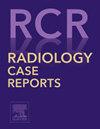Bronchial artery embolization as a life-saving method in a case of massive hemoptysis secondary to a hemorrhagic bullous emphysema
Q4 Medicine
引用次数: 0
Abstract
Bullous emphysema, often associated with COPD, can lead to severe complications like massive hemoptysis. The Bronchial artery embolization (BAE) has become a well-established and effective procedure for the management of hemoptysis, which is the expectoration of blood from the lower respiratory tract. First introduced in the 1970s, BAE has evolved significantly due to advancements in interventional radiology techniques and embolic materials. The success rate of BAE in controlling acute hemoptysis ranges from 70% to 90% in the literature. However, recurrence rates remain a challenge, with studies reporting recurrence in up to 20%-30% of cases within the first year, often due to incomplete embolization or disease progression. Repeat embolization is frequently required in these patients, highlighting the importance of close follow-up and management of the underlying disease.
This case report describes a 55-year-old patient with a history of pulmonary tuberculosis, chronic smoking, and advanced COPD who presented with significant hemoptysis due to a hemorrhagic emphysematous bulla. Due to the patient's fragile condition, surgical intervention was deemed too risky, and embolization was chosen as a less invasive alternative. The procedure successfully controlled the bleeding without complications. This case highlights the importance of bronchial artery embolization (BAE) as a life-saving intervention in cases of massive hemoptysis, particularly in patients unfit for surgery. While BAE provides an effective solution for acute bleeding, long-term management of COPD and close follow-up are essential to prevent recurrence. A multidisciplinary approach is crucial for optimal patient outcomes.
大疱性肺气肿通常与慢性阻塞性肺疾病相关,可导致大咯血等严重并发症。支气管动脉栓塞术(BAE)已成为治疗咯血(即下呼吸道排血)的一种行之有效的方法。随着介入放射学技术和栓塞材料的发展,BAE 已取得了长足的进步。在文献中,BAE 控制急性咯血的成功率从 70% 到 90% 不等。然而,复发率仍然是一个挑战,研究报告显示,第一年内复发的病例高达 20%-30%,通常是由于栓塞不完全或疾病进展所致。本病例报告描述了一名 55 岁的患者,有肺结核、长期吸烟和晚期慢性阻塞性肺病病史,因出血性气肿性大泡而出现严重咯血。由于患者病情脆弱,手术治疗风险太大,因此选择了栓塞疗法作为创伤较小的替代方法。手术成功控制了出血,没有出现并发症。本病例强调了支气管动脉栓塞术(BAE)作为大咯血病例中挽救生命干预措施的重要性,尤其是对于不适合手术的患者。虽然 BAE 能有效解决急性出血问题,但慢性阻塞性肺病的长期治疗和密切随访对防止复发至关重要。多学科方法对于患者获得最佳治疗效果至关重要。
本文章由计算机程序翻译,如有差异,请以英文原文为准。
求助全文
约1分钟内获得全文
求助全文
来源期刊

Radiology Case Reports
Medicine-Radiology, Nuclear Medicine and Imaging
CiteScore
1.10
自引率
0.00%
发文量
1074
审稿时长
30 days
期刊介绍:
The content of this journal is exclusively case reports that feature diagnostic imaging. Categories in which case reports can be placed include the musculoskeletal system, spine, central nervous system, head and neck, cardiovascular, chest, gastrointestinal, genitourinary, multisystem, pediatric, emergency, women''s imaging, oncologic, normal variants, medical devices, foreign bodies, interventional radiology, nuclear medicine, molecular imaging, ultrasonography, imaging artifacts, forensic, anthropological, and medical-legal. Articles must be well-documented and include a review of the appropriate literature.
 求助内容:
求助内容: 应助结果提醒方式:
应助结果提醒方式:


